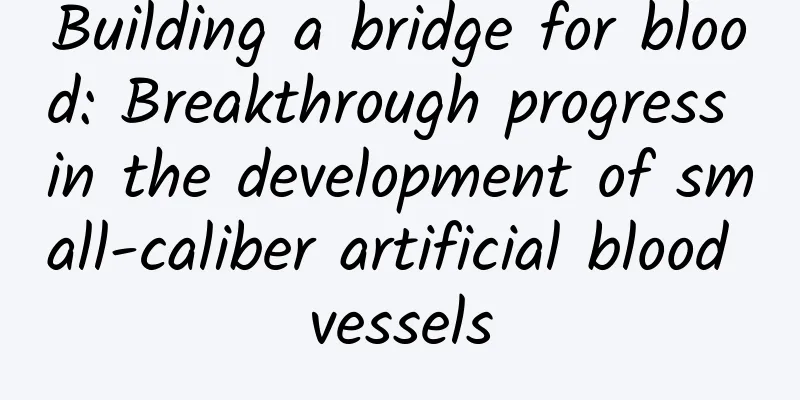Building a bridge for blood: Breakthrough progress in the development of small-caliber artificial blood vessels

|
As people's living standards improve, unhealthy lifestyles such as smoking, drinking, staying up late, and lack of exercise have gradually spread into people's daily lives. One of the consequences of this trend is that the incidence of cardiovascular disease among Chinese citizens continues to rise. Data from the "China Cardiovascular Health and Disease Report 2020" shows that cardiovascular disease deaths in China rank first among the total causes of death among urban and rural residents. The "China Cardiovascular Disease Medical Quality Report 2021" also clearly points out that cardiovascular disease is currently the leading cause of death among Chinese residents . Image source: veer gallery Artificial blood vessels are an important medical device in the treatment of cardiovascular diseases. For severe cardiovascular diseases, vascular transplantation is often the most effective treatment. By replacing diseased blood vessels with artificial blood vessels, the blood circulation needs of the human body can be ensured. Recently, the Technical Institute of Physics and Chemistry of the Chinese Academy of Sciences and the Beijing Anzhen Hospital affiliated to Capital Medical University have worked together to jointly apply anticoagulant factor drugs and antiplatelet drugs. By giving small-caliber blood vessels a "double anticoagulant effect", they have developed small-caliber artificial blood vessels that can effectively resist acute thrombosis. So, why are small-caliber artificial blood vessels of particular interest? What are the difficulties in their development? What progress has been made in this research and development? Let us take a look. Artificial blood vessels: small has its own difficulties The thickest blood vessels in the human body, such as the aorta, can reach a diameter of more than 30 millimeters, while the thinnest capillaries have a diameter of only one hundredth of a millimeter, a thousand times difference in thickness. Therefore, in order to replace human blood vessels, we need to develop artificial blood vessels of different diameters. Generally, artificial blood vessels with a diameter less than 6 mm are classified as small-caliber artificial blood vessels, while those with a diameter greater than 6 mm are classified as large-caliber artificial blood vessels. At present, due to the unavoidable problems of thrombosis and intimal hyperplasia, the long-term patency rate of small-caliber artificial blood vessels is very low, so there is an urgent need to develop a small-caliber blood vessel for clinical application. The reasons for the failure of small-caliber blood vessel transplantation are mainly the following: First, the blood flow rate in small blood vessels is relatively slow and the blood stays for a long time, so the platelets in the blood have enough time to gather on the surface of the "non-human" material of the artificial blood vessel, triggering a coagulation reaction, thus leading to the occurrence of acute thrombosis in the early stage of transplantation. Secondly, due to factors such as incomplete intima and inflammation, smooth muscle cells are prone to excessive proliferation, resulting in intimal hyperplasia, which can cause stenosis again when small blood vessels are implanted for a long time. Third, due to limitations in preparation materials and anastomosis technology, there is often a compliance mismatch between artificial blood vessels and natural blood vessels, which can easily lead to problems such as intimal hyperplasia and restenosis of the lumen. In contrast, large blood vessels have a high blood flow rate, a fast blood flow rate, and a strong flushing effect, so they are less likely to clot; secondly, the lumen of large blood vessels is wide, and local thrombosis and intimal hyperplasia have little effect on them, which is fatal to small blood vessels. The clinical application of small-caliber artificial blood vessels faces many challenges. In this collaborative research between the Institute of Physical and Chemical Research of the Chinese Academy of Sciences and Beijing Anzhen Hospital, scientists focused on the problem of how to prevent acute thrombosis in the early stages of transplantation and carried out research and development of new small-caliber artificial blood vessels. Heparin + aspirin, dual-effect anticoagulation We know that the purpose of blood coagulation is to plug ruptured blood vessels so that we don't bleed profusely due to a small wound. The mechanism of blood coagulation is relatively complex. To put it simply, platelets participate in the activation of fibrinogen to form a fibrin network. The fibrin network acts as a "rebar" and fills the "concrete" of red blood cells to quickly build a wall to plug the hole. However, when it comes into contact with an artificial blood vessel, a non-living object, the blood coagulation mechanism will be triggered, and blood clots will grow inside the artificial blood vessel due to coagulation, leading to transplant failure. Since the formation of blood clots depends on fibrin and platelets, the research team tried to prevent the appearance of these two substances in artificial blood vessels, and from this perspective, to develop new artificial blood vessels. On the one hand, people already know that under the combined action of multiple coagulation factors, fibrinogen in the blood is converted into fibrin. Heparin is a substance that can effectively counteract coagulation factors, so it is often used to prevent thrombosis or increase uterine blood supply during pregnancy. On the other hand, platelet aggregation is also one of the important prerequisites for thrombosis. Aspirin, a long-standing drug, has a good antiplatelet effect, which can prevent platelets from functioning and thus prevent the occurrence of thrombosis. So, can combining heparin and aspirin and embedding them into artificial blood vessels prevent the occurrence of blood clots and thus improve the success rate of small-caliber artificial blood vessel transplantation? Based on this idea, the research team conducted a series of studies. Schematic diagram of the preparation and function of PCL/PU-HepA vascular stent (Image source: provided by the author) First, scientists chose a composite material of polycaprolactone (PCL) and polyurethane (PU) as the building material for the new artificial blood vessel. By precisely controlling the ratio of the two, the mechanical properties of the artificial blood vessel can be adjusted. Secondly, when introducing heparin and aspirin into artificial blood vessels, scientists tried many rounds of experimental conditions and finally found a method to prepare heparin-aspirin complex by slow reaction under mild conditions. In this way, the small molecule aspirin can be attached to the large molecule heparin, thereby introducing two drugs into the artificial blood vessel at one time, thereby exerting a more powerful anticoagulant function. Conclusion Thus, a new type of small-caliber artificial blood vessel was born. This artificial blood vessel stent material is mainly prepared by electrospinning, and the preparation technology is relatively mature. The synthesis and grafting of heparin-aspirin complex is also relatively easy to achieve. Limited by the production efficiency of electrospinning and the limitations of organic synthesis reactions, the artificial blood vessel is still in the laboratory research and development stage. However, in the process of scientific exploration, the realization from "0" to "1" is often more important and more fundamental than from "1" to "100". I believe that in the near future, with the further improvement of this new technology and the improvement of production efficiency, the new small-caliber artificial blood vessel will play a greater role in the fight against cardiovascular diseases. Author: Li Lei, Zhou Siyuan, Wu Dayong, Yang Xiubin Author's unit: Technical Institute of Physics and Chemistry, Chinese Academy of Sciences, Beijing Anzhen Hospital, Capital Medical University This article is from the "Science Academy" public account. Please indicate the source of the public account when reprinting. |
>>: The farce of “Qin Lang lost his homework” has come to an end. Have you been deceived too?
Recommend
Are there bacteria that "eat paper" in nature?
When I saw a netizen asking "Are there bacte...
Olympic ratings plummet: Will NBC's tragedy happen again in China four years later?
With the official end of the Olympic Games on Aug...
Baidu Search oCPC Optimization Guide
Many friends came to ask me, why did their search...
Haofang Law School's "Wang Fang's Reading Class" improves children's reading ability
Haofang Law School's "Wang Fang's Rea...
Durex for Halloween will make you ready to scream, and with the right creativity, demons and monsters can be transformed into cute pets in seconds!
Do you know? Halloween is a traditional Western f...
6-month-old baby early education training course video full set (56 episodes) Baidu cloud download
6-month-old baby early childhood training course ...
If there were no words in the world
You know What word is this? (The answer will be r...
[Popular Science of Chinese Military Technology] Victory or defeat is decided in silence - how important will electronic confrontation in aerospace be in the future?
With the rapid development of aerospace technolog...
Can an air fryer really cook out of thin air?
Fried chicken legs, fried meatballs, fried fish, ...
Changan Dashiren 2020 Special Class Video Course
Introduction to Changan Dashiren's 2020 small...
Event operation: 6 common types of event link title copywriting!
Event planning and operation is a job that every ...
Analysis of 4 factors of Keep user experience!
A week ago, QuestMobile released the "China ...
When her son ate his classmate’s birthday cake, his mother angrily claimed in the WeChat group that he was “poisoned”. Is it really true that you can’t eat a single bite of vegetable cream?
A piece of social news has sparked heated discuss...
How brands can be revitalized through private domain marketing
Since the concept of private domain marketing has...
Do hummingbirds have Mulan? To avoid being disturbed by their own kind, some females choose to "dress as men"
Produced by: Science Popularization China Author:...









